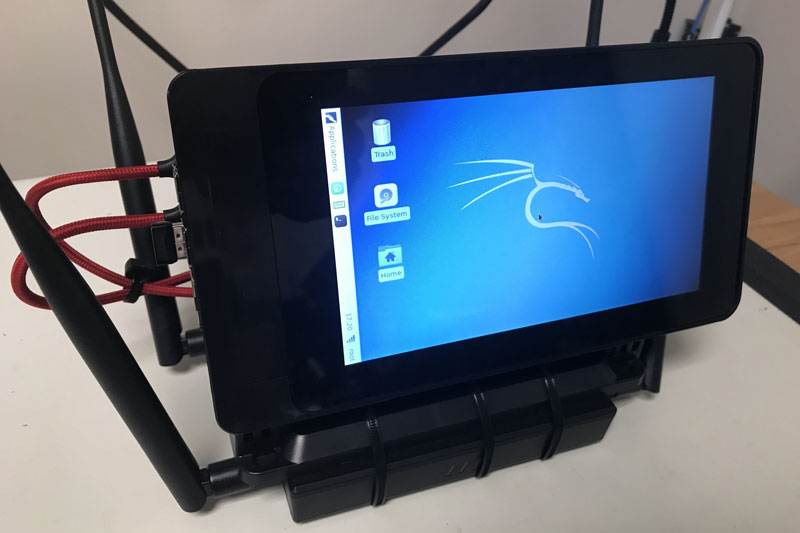Sometimes you need to hack on the go. [Supertechguy] has put together an interesting system for hacking on the hoof called the Pineapple Pi. This combines a Raspberry Pi 3 with a seven-inch touchscreen and a Hak 5 WiFi Pineapple into a handy portable package that puts all of the latest WiFi and ethernet hacking tools to hand. The package also includes a 20,100 mAh battery, so you won’t even need a wall socket to do some testing. It’s a bit of a rough build — it is held together with velcro, for instance — but it’s a good place to start if you are looking to make a portable, standalone system for testing WiFi networks.
The Pi 3 at the heart of the system is running Kali Linux, but it is mainly used as a way to access the interface of the WiFi Pineapple, so you could probably lower the cost a bit by replacing it with a Pi Zero. We have seen quite a lot of similar mobile hacking stations, including flying ones, ones based on the cheap Pi Zero and ones based on the Nexus 5 cell phone. This one has certain advantages, though: it is easier to upgrade as it runs on more recent hardware, and it can use devices like a USB keyboard for more extended hacking sessions, and the battery is big enough to keep the device running for several hours, which is another plus for extended security audits.
















Heh, I’m working on something similar. But Wifi is one such thing it can do. Put it this way: I want a platform in which I can sniff on wireless keyboards, diddle with someone’s wifi, be bad on bluetooth, take over wireless microphones, *become* a GPS constellation. And add in pirate radio stations, analogTV, and more.
My only problem is that I’m CPU bound with some actions I want to do. And the RasPi is nowhere near powerful enough for my needs.
Perhaps you could use a NUC’s system board as a base? Some DIY laptops go that route.
Hmm, I have a spare NUC. Good idea.
I do more emdedded work, and not as sure how to do a battery backed NUC. Do you know of any general guides and traps/tricks I should watch out for?
If you’d like to take it off here, feel free to message over Twitter. @CrankyLinuxUser :)
Just use a phone power bank.
Sorry, you can’t use phone powerbanks on intel nuc, but theres a lot of lithium 12v camera battery on that will do the job.
You may be able to use a QC3/QC2 power bank to deliver 12v. I am unsure if the current requirement suits a nuc. From my reading QC3/QC2 uses a simple protocol compared to USB PD which is another option.
Depending on NUC’s voltage tolerance it could be possible to just use laptop battery or few of them in parallel. 3C is 9-12.6V, and 4C is 12-16.8V. Also step-down converters with few of amps capability can be used to bring 4C laptop battery to 12V for entire discharge cycle.
Hell, you could even use a laptop– buy an older workstation-class laptop, or just a bigger one with extra space in it- you get x86_64 platform support, as much RAM as you can fit in, a built-in UPS, etc. Need more space? You don’t need a CD drive, do you? That’s enough space for a stripped Uno and a pi Zero, and you can go smaller.
One of my laptop’s USB ports broke, so I desoldered it, added some wires, and then wired in a Pi Zero W and put it into some dead space. If you have a broken SD card slot, use that for your pi’s boot drive, etc.
Stuff like the Pinebook (which looks pretty modern, and has a bunch of dead space) isn’t perfect, but could do a couple of tricks:
https://hackaday.com/2017/04/28/hands-on-with-the-pinebook/
If you’re building something portable, try starting with something portable.
Have you looked at Nvidia’s Jetson platform? It’s a large cluster of smaller processors rather than a couple larger ones. It’s penchant for CV applications could be leveraged for brute forcing no problem.
SDR work requires fast CPUs to handle the load on each function.
Now, classification of 3megasamples/s might be ideal for a floating point vector cpu (GPU), but I don’t have that code available.
Just use an older laptop, wtf why are you so thick. With PMCIA and USB, possibilities are near-endless.
Exceptthe possibilities are limited, as you’ll easily hit the max bandwith of both interfaces :P
USB 2.0 caps as 480Mb/s, PCMCIA 1064Mb/s
“Hacking on the go”
What does this actually mean? It’s a cool project, but I don’t understand what the intended use of the device is.
Maybe you can use custom GL shaders to offload some work to GPU?
Interesting project! I did something similar with a beaglebone a couple years ago and had similar issues: the CPU would watchdog under heavy wifi load. I changed to a Linux/Intel laptop with a high-gain wifi device for monitoring. I still use it. Cheaper and more powerful than a comparable NUC with RAM/disk/monitor/etc. I have two 9-cell batteries to keep it going.
pi pineapple wifi pi